PPARγ agonist through the terminal differentiation phase is essential for adipogenic differentiation of fetal ovine preadipocytes
- PMID: 28536637
- PMCID: PMC5415806
- DOI: 10.1186/s11658-017-0037-1
PPARγ agonist through the terminal differentiation phase is essential for adipogenic differentiation of fetal ovine preadipocytes
Abstract
Background: Although the 3T3-L1 preadipocyte cell line represents an informative model for in vitro adipogenesis research, primary cultured cells are often needed to understand particular human or animal metabolic phenotypes. As demonstrated by in vitro cultured preadipocytes from large mammalian species, primary cultured cells require specific adipogenic differentiation conditions different to that of the 3T3-L1 cell line. These conditions are also species-specific and require optimization steps. However, efficient protocols to differentiate primary preadipocytes using alternative species to rodents are scarce. Sheep represent an amenable animal model for fetal biology and developmental origins of health and disease studies. In this work, we present with the first detailed procedure to efficiently differentiate primary fetal and adult ovine preadipocytes.
Methods: Fetal and adult ovine adipose and skin tissue harvest, preadipocyte and fibroblast isolation, proliferation, and standardization and optimization of a new adipogenic differentiation protocol. Use of commercial cell lines (3T3-L1 and NIH-3T3) for validation purposes. Oil red O stain and gene expression were used to validate adipogenic differentiation. ANOVA and Fisher's exact test were used to determine statistical significance.
Results: Our optimized adipogenic differentiation method included a prolonged adipogenic cocktail exposure time from 2 to 8 days, higher insulin concentration, and supplementation with the peroxisome proliferator-activated receptor gamma (PPARγ) agonist, rosiglitazone. This protocol was optimized for both, fetal and adult preadipocytes.
Conclusions: Our protocol enables successful adipogenic differentiation of fetal and adult ovine preadipocytes. This work demonstrates that compared to the 3T3-L1 cell line, fetal ovine preadipocytes require a longer exposure to the differentiation cocktail, and the need for IMBX, dexamethasone, and/or the PPARγ agonist rosiglitazone through the terminal differentiation phase. They also require higher insulin concentration during differentiation to enhance lipid accumulation and similar to human primary preadipocytes, PPARγ agonist supplementation is also required for ovine adipogenic differentiation. This work highlights species-specific differences requirements for adipogenic differentiation and the need to develop standardized methods to investigate comparative adipocyte biology.
Keywords: Adipogenic differentiation; Fetal; Preadipocyte; Sheep.
Figures
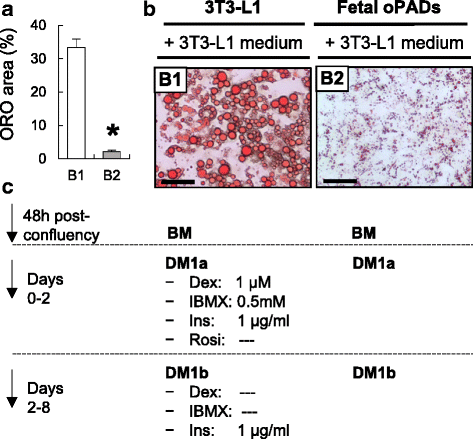
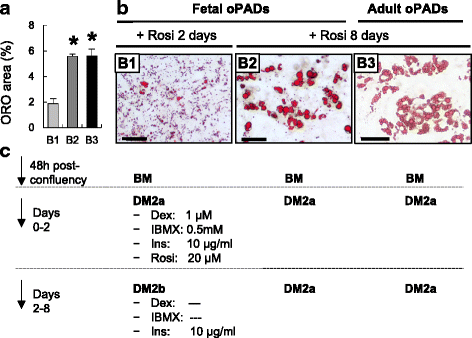
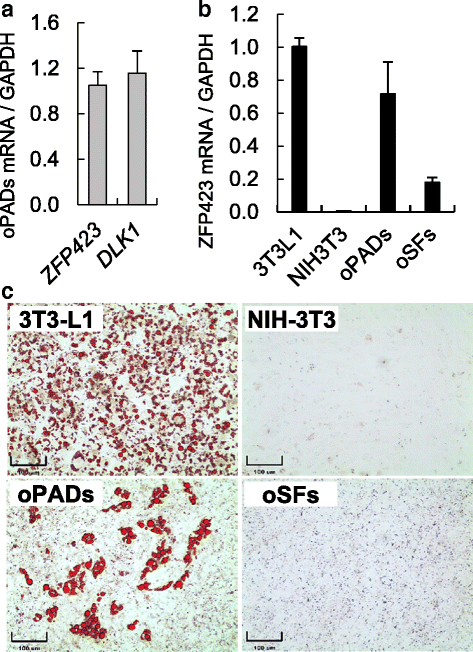
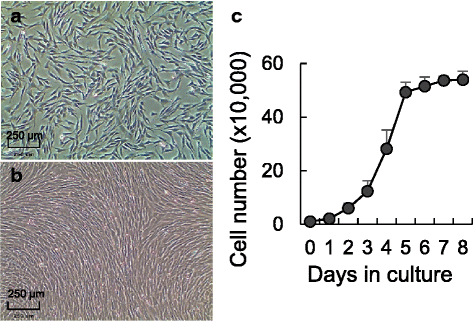
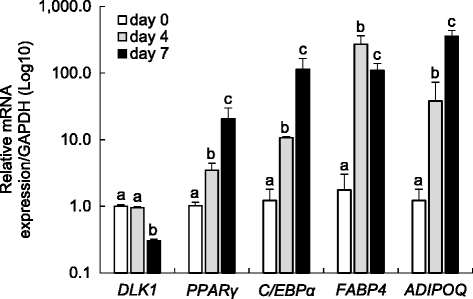
Similar articles
-
Prolonged induction activates Cebpα independent adipogenesis in NIH/3T3 cells.PLoS One. 2013;8(1):e51459. doi: 10.1371/journal.pone.0051459. Epub 2013 Jan 10. PLoS One. 2013. PMID: 23326314 Free PMC article.
-
Bisphenol S- and bisphenol A-induced adipogenesis of murine preadipocytes occurs through direct peroxisome proliferator-activated receptor gamma activation.Int J Obes (Lond). 2016 Oct;40(10):1566-1573. doi: 10.1038/ijo.2016.95. Epub 2016 May 13. Int J Obes (Lond). 2016. PMID: 27273607
-
Dechlorane Plus increases adipogenesis in 3T3-L1 and human primary preadipocytes independent of peroxisome proliferator-activated receptor γ transcriptional activity.Int J Obes (Lond). 2019 Mar;43(3):545-555. doi: 10.1038/s41366-018-0072-7. Epub 2018 May 1. Int J Obes (Lond). 2019. PMID: 29717277
-
Insulin interacts with PPARγ agonists to promote bovine adipocyte differentiation.Domest Anim Endocrinol. 2024 Jul;88:106848. doi: 10.1016/j.domaniend.2024.106848. Epub 2024 Mar 29. Domest Anim Endocrinol. 2024. PMID: 38574690 Review.
-
[Characterization of novel genes regulating adipocyte differentiation].Yakugaku Zasshi. 2007 Jan;127(1):135-42. doi: 10.1248/yakushi.127.135. Yakugaku Zasshi. 2007. PMID: 17202794 Review. Japanese.
Cited by
-
Brown and beige adipose tissue: a novel therapeutic strategy for obesity and type 2 diabetes mellitus.Adipocyte. 2021 Dec;10(1):48-65. doi: 10.1080/21623945.2020.1870060. Adipocyte. 2021. PMID: 33403891 Free PMC article. Review.
-
Sex-Specific Modulation of Fetal Adipogenesis by Gestational Bisphenol A and Bisphenol S Exposure.Endocrinology. 2017 Nov 1;158(11):3844-3858. doi: 10.1210/en.2017-00615. Endocrinology. 2017. PMID: 28938450 Free PMC article.
-
High fructose exposure modifies the amount of adipocyte-secreted microRNAs into extracellular vesicles in supernatants and plasma.PeerJ. 2021 May 19;9:e11305. doi: 10.7717/peerj.11305. eCollection 2021. PeerJ. 2021. PMID: 34055478 Free PMC article.
-
Application of In Vitro Models for Studying the Mechanisms Underlying the Obesogenic Action of Endocrine-Disrupting Chemicals (EDCs) as Food Contaminants-A Review.Int J Mol Sci. 2023 Jan 5;24(2):1083. doi: 10.3390/ijms24021083. Int J Mol Sci. 2023. PMID: 36674599 Free PMC article. Review.
-
Lesson on obesity and anatomy of adipose tissue: new models of study in the era of clinical and translational research.J Transl Med. 2024 Aug 14;22(1):764. doi: 10.1186/s12967-024-05547-3. J Transl Med. 2024. PMID: 39143643 Free PMC article. Review.
References
-
- Benyshek DC. The “early life” origins of obesity-related health disorders: new discoveries regarding the intergenerational transmission of developmentally programmed traits in the global cardiometabolic health crisis. Am J Phys Anthropol. 2013 - PubMed
MeSH terms
Substances
Grants and funding
LinkOut - more resources
Full Text Sources
Other Literature Sources
Research Materials

